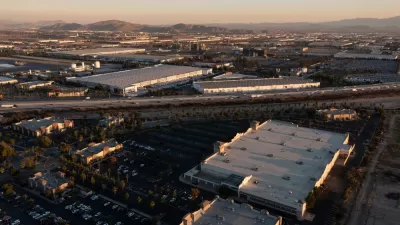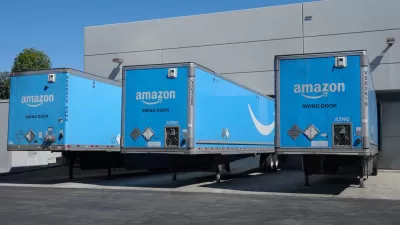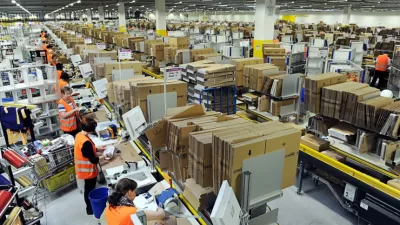Today’s massive modern distribution centers have outsized impacts on adjacent neighborhoods. But outdated zoning codes often let them slip through the cracks with no environmental review.

New York City’s zoning code isn’t written for modern warehouse facilities, according to an article in Next City by María Paula Rubiano A., letting companies like Amazon build massive facilities with little or no environmental oversight. “At the time the zoning code was written, it was a fairly accurate assessment. Warehouses in the ’60s were generally used to store things before they arrived at retailers. Freight came and went at certain hours, and the buildings were relatively small, standing, on average, less than 30 feet, or two stories tall. ”
Today, however, warehouses are “creatures of an entirely new logistics system,” bigger and taller than ever before. “Some estimates calculate that modern warehouses can bring around 1,000 additional daily truck trips to a surrounding neighborhood. The presence of these extra vehicles can worsen local air quality, upping the risk of asthma, heart attacks, and premature deaths.”
But according to the city’s zoning code, “Last-mile facilities built today still fall under the 1961 definition of a warehouse,” triggering no environmental requirements. This doesn’t just happen in New York City: “The United States is the only industrialized country without a national, standardized zoning code — meaning that there’s no universal definition of what a modern warehouse is, how hazardous it should be considered, and where it should be placed.”
Environmental justice advocates warn that not updating environmental regulations for distribution centers perpetuates historic injustice. “A recent investigation by Consumer Reports and The Guardian found that Amazon, which opened more fulfillment centers in 2020 than in the four years prior combined, has placed 69 percent of all its facilities in neighborhoods with a greater percentage of people of color.”
But zoning changes alone won’t protect public health from existing facilities. To mitigate the effects of air pollution on neighborhoods near fulfillment centers, “Last May, California’s South Coast Air Quality Management District approved the first legislation in the country regulating the indirect sources of pollution — trucks and cars — generated by the giant warehouse facilities.”
This set of regulations could serve as a model for holding warehouse builders accountable for environmental impacts.
FULL STORY: A ‘Warehouse’ by Any Other Name

Alabama: Trump Terminates Settlements for Black Communities Harmed By Raw Sewage
Trump deemed the landmark civil rights agreement “illegal DEI and environmental justice policy.”

Planetizen Federal Action Tracker
A weekly monitor of how Trump’s orders and actions are impacting planners and planning in America.

How Atlanta Built 7,000 Housing Units in 3 Years
The city’s comprehensive, neighborhood-focused housing strategy focuses on identifying properties and land that can be repurposed for housing and encouraging development in underserved neighborhoods.

In Both Crashes and Crime, Public Transportation is Far Safer than Driving
Contrary to popular assumptions, public transportation has far lower crash and crime rates than automobile travel. For safer communities, improve and encourage transit travel.

Report: Zoning Reforms Should Complement Nashville’s Ambitious Transit Plan
Without reform, restrictive zoning codes will limit the impact of the city’s planned transit expansion and could exclude some of the residents who depend on transit the most.

Judge Orders Release of Frozen IRA, IIJA Funding
The decision is a victory for environmental groups who charged that freezing funds for critical infrastructure and disaster response programs caused “real and irreparable harm” to communities.
Urban Design for Planners 1: Software Tools
This six-course series explores essential urban design concepts using open source software and equips planners with the tools they need to participate fully in the urban design process.
Planning for Universal Design
Learn the tools for implementing Universal Design in planning regulations.
Caltrans
Smith Gee Studio
Institute for Housing and Urban Development Studies (IHS)
City of Grandview
Harvard GSD Executive Education
Toledo-Lucas County Plan Commissions
Salt Lake City
NYU Wagner Graduate School of Public Service





























